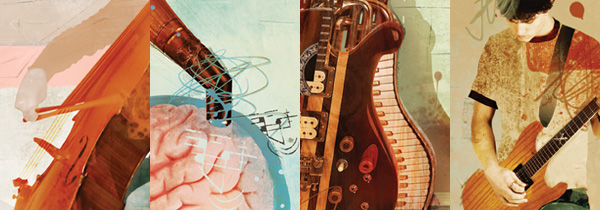 |
 |
||||||||||||||

A Space for Music
In celebration of the Perry and Marty Granoff Music Center, artists and scholars examine music’s place in our minds, our society, and our worldIntroduction
A well-designed music building is a musical instrument, and the new Perry and Marty Granoff Music Center at Tufts is among the finest. All those design meetings, with their presentations describing in mathematical detail the curvature of the wall panels and the connectors beneath the floors, did not prepare me for the shock to my nervous system when the first chords were struck on the nine-foot concert grand and the Distler Performance Hall came alive.
Artistic gestures—whether in music, dance, or painting—are difficult to put into words. In academic environments, where scholarly language is the coin of the realm, artistic expression typically is subordinated to what one might say about it. As someone who studies the science of music, I do try to understand music in ways I can explain. But as a musician, I am particularly pleased that we have created a structure that affirms artistic expression on its own terms.
Of course, this magnificent building is more than the sounds resonating within it. It has an external resonance, too, one that it creates by asserting the central role of the arts in education and culture. Historically, universities have served to preserve, study, and push the boundaries of culture. With this building we secure our commitment to fulfilling that mission. The building will enable us to build on our already strong music program. It will enable us to recruit the very best students and faculty for years to come. It also enables us to reach out to our host communities.
In keeping with Tufts’ commitment to international learning, this building is dedicated to the music of East and West. We cannot understand each other without understanding each other’s cultures. One of the many highlights of a tour through the building is the world cultures room, which houses our glorious Indonesian gamelan instruments and reveals the vibrancy of our global perspective on the arts.
Musicians and artists are at the leading edges of the development of community and culture, even though they often find themselves scraping together a living on the fringes of society. Although artists are not typically thought of as leaders, that is precisely what they are. They bring communities together, contribute to individual and collective well-being, renew neighborhoods, spark our imagination, and provide the cultural glue and identity of each generation. At Tufts, we place a premium on civic engagement and public service—ideals that musicians embody perfectly.
In the essays that follow, faculty and alumni reflect on the art and science of music. Researchers explore the effect of music on our emotions, our bodies, and our brains. Composers and musicologists ponder artistic process and inspiration. Innovators consider the impact of technology on the future of the music industry. Musicians testify to the joy of performance and the powerful connections a shared love of music can forge. As the final two essays demonstrate, that power can become a tool for social change, whether it is using opera to educate schoolchildren, or rock bands to raise environmental awareness.
Our beautiful new space for music will enrich generations of Tuftonians and other community members. I hope you will visit soon. Meanwhile, I invite you to read about how we, as individuals and as a society, create a space for music.